


In December 2012, NetApp began shipping its first all flash array: the EF540. The EF540 is designed to provide the throughput and submillisecond latency of flash combined with the enterprise reliability and features that you expect from NetApp.
The EF540 is part of our complete flash portfolio, which also includes a full range of hybrid storage (flash plus HDD) and server flash options. (Check out this recent Tech OnTap article on the NetApp® Virtual Storage Tier.)
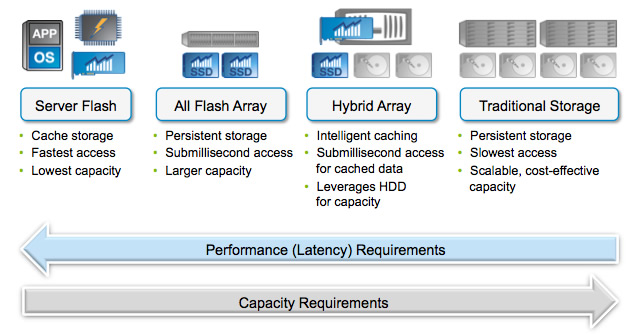
Figure 1) NetApp offers a complete flash portfolio that allows you to satisfy the specific performance requirements of your applications at minimum cost.
More choices give you more degrees of freedom to find the right solution at the right price. This article explains where all flash arrays fit and describes the EF540 in terms of performance, efficiency, reliability, and enterprise features.
Why Choose an All Flash Array?

All flash arrays are a new class of storage designed to overcome two significant performance limitations of hard disk drives (HDDs):
- An HDD is capable of performing no more than 300–400 random I/O operations per second (IOPS). A storage system that must handle tens of thousands of IOPS requires hundreds of HDDs to achieve the necessary performance—even when the capacity is not needed. (See Figure 1.)
- The fastest HDDs have access times of 3–4 milliseconds, slowing response times for latency-sensitive applications.
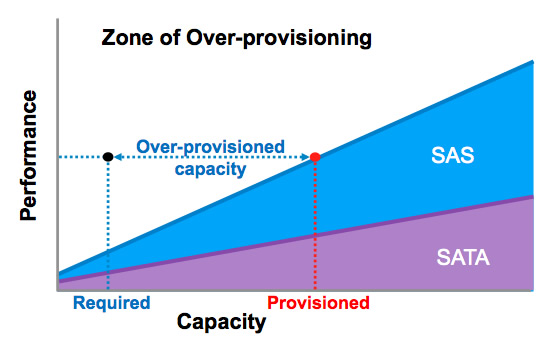
Figure 2) Some combinations of performance and capacity can’t be satisfied by hard disk drives without over-provisioning. This “zone of over-provisioning” is where all flash arrays offer the best fit.
By comparison, flash-based SSDs achieve latencies measured in microseconds and perform tens of thousands of IOPS per device. The only catch—as you are probably aware—is that SSDs cost more than HDDs on a capacity basis. This means that, for now, all flash arrays make the most sense in situations in which:
- The performance requirement would otherwise result in over-provisioning.
- Consistent, high IOPS are needed.
- Lowering latency has a significant impact.
- The impact of having to warm a data cache to achieve optimum IOPS and latency is unacceptable.
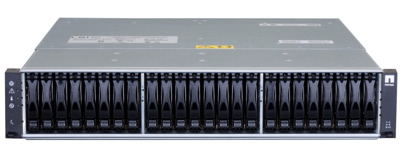 Understanding the EF540
Understanding the EF540

The EF540 is designed to deliver superior performance, efficiency, and availability in a platform that leverages the knowledge and experience gained from a legacy of over 500,000 deployed storage systems. It’s ideal for performance-driven applications with submillisecond latency requirements. With the EF540, your business-critical applications deliver results faster—achieving response times only possible with all flash storage.
Housed in a 2U shelf and configured with either 12 or 24 800GB SSDs, a single system delivers up to 19.2TB of raw capacity. We qualified enterprise multilevel cell SSDs for their exceptional price/performance and capacity. SSDs can be configured in RAID volumes using RAID 0, RAID 1, RAID 3, RAID 5, RAID 6, or RAID 10.
The EF540 includes four 8Gb FC connections. A full range of additional host connectivity options—including additional FC ports, 6Gb SAS ports, 10GbE (for iSCSI), and 40Gb InfiniBand—is available. (On-board FC ports are not available when InfiniBand is in use.)
Table 1) EF540 feature summary.
| Core Attribute | EF540 |
Base host connectivity (ports per controller) |
|
Controller memory/cache |
|
Form factor |
|
Drive |
|
Storage OS |
|
| Optional Features | EF540 |
| Expansion host connectivity (ports per controller) |
|
| Optional SANtricity replication features (requires licensing) |
|
The EF540 runs enterprise-proven SANtricity software, which lets you easily tune a system to achieve maximum performance and utilization. Dual-active controllers with fully redundant, hot swappable components protect availability. Fully redundant I/O paths and automated failover, which—perhaps surprisingly—are not available on some flash arrays, are standard on the EF540.
Performance and Efficiency

When it comes to performance, the EF540 draws on a proven heritage of support for the most demanding high-performance computing environments. It delivers over 300,000 IOPS of predictable, repeatable, and sustainable performance with demonstrated submillisecond latency. That’s equivalent to the transactional performance of over 1,000 traditional 15K HDDs, enabling you to meet the same performance requirement with 95% less space, power, and cooling for maximum efficiency.
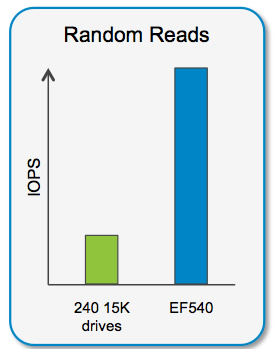
Figure 3) EF540 random read performance relative to HDDs.
It’s also worth noting that the EF540 can deliver up to 6 gigabytes/sec throughput to accommodate applications that handle I/O in large blocks or require large sequential bursts of data.
Enterprise Reliability and Availability

The EF540 combines field-proven technology and enterprise features that other all flash offerings lack, protecting your valuable data and delivering uninterrupted availability.
Hardware Features
The array is architected to deliver enterprise levels of availability with:
- Dual-active controllers, fully redundant I/O paths, and automated failover
- Battery-backed cache memory that is destaged to flash upon power loss
- Extensive monitoring of diagnostic data that provides comprehensive fault isolation, simplifying analysis of unanticipated events for timely problem resolution
- Proactive repair that helps get the system back to optimal performance in minimum time
- Enterprise-class SSDs that incorporate the latest features for flash reliability and life
- SSD wear-life tracking alerts you when drives should be replaced
Online Management
All management tasks can be performed while the EF540 remains online with complete read/write data access. This allows you to make configuration changes and conduct maintenance without disrupting application I/O or scheduling planned downtime.
Advanced Tuning
The EF540 includes advanced tuning functions so you can optimize performance with minimal effort. We’ve been handling storage for high-performance computing and other demanding applications for a long time, so we know which capabilities need to be tunable. With the EF540, you can tune any attribute to meet specific application needs. For example, if you initially configure a volume to use RAID 5 but later decide that RAID 10 would better suit your application, you can dynamically convert the volume with no disruptions.
Graphical performance tools give you several viewpoints into array I/O activity. The ability to view data in real time helps you make better-informed decisions.
Enterprise Data Protection
Another feature set that many all flash arrays are short on is data protection. The EF540 provides a flexible data protection and disaster recovery architecture that includes enterprise features such as:
- High-speed, high-efficiency Snapshot copies that let you protect data in seconds and reduce storage consumption by storing only changed blocks
- Synchronous mirroring for no-data-loss protection of business-critical data
- Asynchronous mirroring for long-distance protection and compliance with business requirements
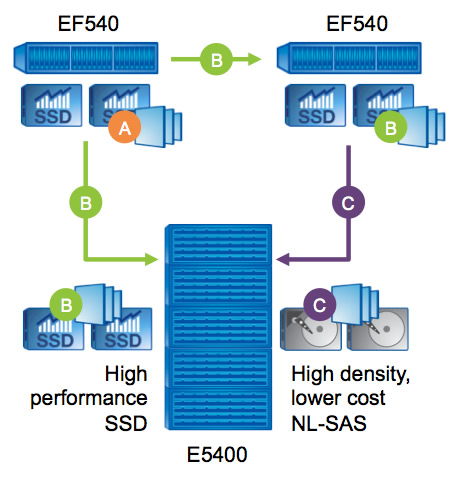
Figure 4) EF540 data protection architecture. A=snapshot, B=sync mirroring, C=async mirroring. Note that you can perform synchronous mirroring between EF540s or to a NetApp E-Series system that has SSD shelves. Async mirroring can potentially use NL-SAS as a replication target.
Conclusion

The EF540 combines low-latency performance, maximum efficiency, and enterprise-class reliability. It’s the industry’s first all flash array that combines performance plus enterprise-grade reliability and features. These capabilities improve the speed and agility of your business and the overall effectiveness of your IT operations.





